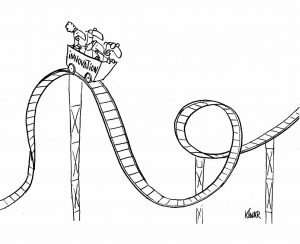 Management is (maybe) a science, but innovation is an art. Traditional corporate decision-making and project management approaches are therefore ill-suited to the ambiguity, high failure rate, pace and multifunctional aspects of innovation.
Management is (maybe) a science, but innovation is an art. Traditional corporate decision-making and project management approaches are therefore ill-suited to the ambiguity, high failure rate, pace and multifunctional aspects of innovation.
 Innovators must play poker rather than chess. Traditional corporate decision-making approaches (“chess”) rely mainly on analyzing facts and minimizing failures – “thinking first”. But managing innovative organizations and capturing sizeable innovation opportunities (“poker”) must also rely on experimentation and proactive learning, combined with ruthless prioritization – “doing first”.
Innovators must play poker rather than chess. Traditional corporate decision-making approaches (“chess”) rely mainly on analyzing facts and minimizing failures – “thinking first”. But managing innovative organizations and capturing sizeable innovation opportunities (“poker”) must also rely on experimentation and proactive learning, combined with ruthless prioritization – “doing first”.
 While traditional project management approaches rely mainly on set targets and task allocations, managing innovative organizations and capturing innovation opportunities also implies planning for changes in the plan and focusing on embedded flexibility and cross-functional mobilization.
While traditional project management approaches rely mainly on set targets and task allocations, managing innovative organizations and capturing innovation opportunities also implies planning for changes in the plan and focusing on embedded flexibility and cross-functional mobilization.
Bibliography
Management is (maybe) a science, but innovation is an art
Keywords: cognitive biases, emerging decision making, innovation project management, nimble, product innovation process
- (Book) Duening, T. N., Hisrich, R. A., & Lechter, M. A. (2014). Technology entrepreneurship: taking innovation to the marketplace. Academic Press.
- (Book) Hamel, G. and Breen, B. (2009) The future of Management; Harvard Business School Press; Boston, Massachusetts
- (Book) Rosenberg, N. (2009). Studies on Science and the Innovation Process: Selected Works of Nathan Rosenberg., World Scientific.
- (Book) Shermer, M. (2011). The believing brain: From ghosts and gods to politics and conspiracies—How we construct beliefs and reinforce them as truths. Macmillan.
- (Video) Daniel Kahneman Intelligent Decision Making 2016
- (Video) Martin Reeves: Your strategy needs a strategy (TED)
- (Article) Adler, P.S., Goldoftas, B., & Levine, D.I. (1999). Flexibility versus Efficiency? A Case Study of Model Changeovers in the Toyota Production System. Organization Science, 10(1), 43-68.
- (Article) Alvarez, S. A., & Barney, J. B. (2007). Discovery and creation: Alternative theories of entrepreneurial action. Strategic Entrepreneurship Journal, 1(1‐2), 11-26.
- (Article) Benner, M. J., & Tushman, M. L. (2003). Exploitation, exploration, and process management: The productivity dilemma revisited. Academy of Management Review, 28(2), 238-256.
- (Article) Berends, H., Jelinek, M., Reymen, I., & Stultiëns, R. (2014). Product innovation processes in small firms: Combining entrepreneurial effectuation and managerial causation. Journal of Product Innovation Management, 31(3), 616-635.
- (Article) Berkhout, G., Hartmann, D., & Trott, P. (2010). Connecting technological capabilities with market needs using a cyclic innovation model. R&D Management, 40(5), 474-490.
- (Article) Bessant, J., & Francis, D. (1997). Implementing the new product development process. Technovation, 17(4), 189-222.
- (Article) Brettel, M., Mauer, R., Engelen, A., & Küpper, D. (2012). Corporate effectuation: Entrepreneurial action and its impact on R&D project performance. Journal of Business Venturing, 27(2), 167-184
- (Article) Brown, S. L., & Eisenhardt, K. M. (1995). Product development: Past research, present findings, and future directions. Academy of Management Review, 20(2), 343-378.
- (Article) Chang, Y. C., Chang, H. T., Chi, H. R., Chen, M. H., & Deng, L. L. (2012). How do established firms improve radical innovation performance? The organizational capabilities view. Technovation, 32(7-8), 441-451.
- (Article) De Waal, G. A., & Knott, P. (2013). Innovation tool adoption and adaptation in small technology-based firms. International Journal of Innovation Management, 17(03), 1340012.
- (Article) Droge, C., Calantone, R., & Harmancioglu, N. (2008). New product success: is it really controllable by managers in highly turbulent environments?. Journal of Product Innovation Management, 25(3), 272-286.
- (Article) Eisenhardt, K. M., & Zbaracki, M. J. (1992). Strategic decision making. Strategic Management Journal, 13(S2), 17-37.
- (Article) Ernst, H. (2002). Success factors of new product development: a review of the empirical literature. International Journal of Management Reviews, 4(1), 1-40.
- (Article) Ethiraj, S. K., & Levinthal, D. (2004). Modularity and innovation in complex systems. Management Science, 50(2), 159-173.
- (Article) Ford, C. M., & Gioia, D. A. (2000). Factors influencing creativity in the domain of managerial decision making. Journal of Management, 26(4), 705-732.
- (Article) Garud, R., Tuertscher, P., & Van de Ven, A. H. (2013). Perspectives on innovation processes. Academy of Management Annals, 7(1), 775-819.
- (Article) Godin, B. (2006). The linear model of innovation: The historical construction of an analytical framework. Science, Technology, & Human Values, 31(6), 639-667.
- (Article) Hrebiniak, L. G. (2006). Obstacles to effective strategy implementation. Organizational dynamics. 35(1), 12–31
- (Article) Hodgkinson, G. P., & Healey, M. P. (2011). Psychological foundations of dynamic capabilities: reflexion and reflection in strategic management. Strategic Management Journal, 32(13), 1500-1516.
- (Article) Kahneman, D., & Lovallo, D. (1993). Timid choices and bold forecasts: A cognitive perspective on risk taking. Management Science, 39(1), 17-31.
- (Article) Klein, K.J., & Sorra, J.S. (1996). The challenge of innovation implementation. Academy of Management Review, 21(4), 1055-1080.
- (Article) Linton, J. D. (2002). Implementation research: state of the art and future directions. Technovation, 22(2), 65-79.
- (Article) Magnusson, M., Boccardelli, P., & Börjesson, S. (2009). Managing the Efficiency-Flexibility Tension in Innovation: Strategic and Organizational Aspects. Creativity and Innovation Management, 18(1), 2-7.
- (Article) Mahdi, S. (2003). Search strategy in product innovation process: theory and evidence from the evolution of agrochemical lead discovery process. Industrial and Corporate Change, 12(2), 235-270.
- (Article) Martinsuo, Miia, et al. “Project-based management as an organizational innovation: Drivers, changes, and benefits of adopting project-based management.” Project Management Journal 37.3 (2006): 87.
- (Article) Miller, R., Olleros, X., & Molinie, L. (2008). Innovation games: a new approach to the competitive challenge. Long Range Planning, 41(4), 378-394.
- (Article) Mintzberg, H., Raisinghani, D., & Theoret, A. (1976). The structure of” unstructured” decision processes. Administrative Science Quarterly, 246-275.
- (Article) Mintzberg, H., & Waters, J.A. (1985). Of strategy: Deliberate and Emergent. Strategic Management Journal, 6(3), 257-272.
- (Article) Mintzberg, H. (1993). The pitfalls of strategic planning. California Management Review, 36, 32-32.
- (Article) Porter, M. E., Lorsch, J. W., & Nohria, N. (2004). Seven surprises for new CEOs. Harvard Business Review, 82(10), 62-75.
- (Article) Salerno, M.S., de Vasconcelos Gomes, L.A., da Silva, D.O., Bagno, R.B., & Freitas, S.L. (2015). Innovation processes: Which process for which project?. Technovation, 35, 59-70.
- (Article) Sarasvathy, S. D., & Venkataraman, S. (2011). Entrepreneurship as method: Open questions for an entrepreneurial future. Entrepreneurship Theory and Practice, 35(1), 113-135.
- (Article) Shane, S. A., & Ulrich, K. T. (2004). 50th anniversary article: Technological innovation, product development, and entrepreneurship in management science. Management Science, 50(2), 133-144.
- (Article) Sheremata, W. A. (2000). Centrifugal and centripetal forces in radical new product development under time pressure. Academy of Management Review, 25(2), 389-408.
- (Article) Simon, H.A., (1959). Theories of Decision Making in Economics. American Economic Review 49, 253–283.
- (Article) Stevenson H.H., Jarillo J.C. (1990) A Paradigm of entrepreneurship: entrepreneurial management. Strategic Management Journal. 11 (Special Issue: Corporate Entrepreneurship. Summer): 17-27.
- (Article) Sull, D., Homkes, R., & Sull, C. (2015). Why strategy execution unravels—and what to do about it. Harvard Business Review, 93(3), 57-66.
- (Article) Tidd, J. (2001). Innovation management in context: environment, organization and performance. International Journal of Management Reviews, 3(3), 169-183.
- (Article) Tidd, J., & Thuriaux‐Alemán, B. (2016). Innovation management practices: cross‐sectorial adoption, variation, and effectiveness. R&D Management, 46(S3), 1024-1043.
- (Article) Tidd, J. (2021). A review and critical assessment of the ISO56002 innovation management systems standard: Evidence and limitations. International Journal of Innovation Management, 25(01), 2150049.
- (Article) Tversky, A., & Kahneman, D. (1974). Judgment under uncertainty: Heuristics and biases. Science, 185(4157), 1124-1131.
- (Article) Wright, C., Sturdy, A., & Wylie, N. (2012). Management innovation through standardization: Consultants as standardizers of organizational practice. Research Policy, 41(3), 652-662.
- (Article) Zahra, S. A., Sapienza, H. J., & Davidsson, P. (2006). Entrepreneurship and dynamic capabilities: A review, model and research agenda. Journal of Management Studies, 43(4), 917-955.
Play poker, not chess: learning and folding
Keywords: beliefs, beta-testing, cheap experiments, dead horses, experimentation, known unknown, learning by doing, Minimum Viable Products, stopping projects
- (Book) Dalkir, K. (2005) “Knowledge Management in Theory and Practice”, Elsevier Butterworth Heinemann
- (Book) Govindarajan, V. and Trimble, C. (2010) The other side of innovation: solving the execution challenge” Harvard Business Review Press
- (Video) Harvard Business Review, (2011). Learn from failure
- (Video) Assessing Failure in Innovation by Kuczmarski Innovation (on Vimeo)
- (Video) Enlightened experimentation, Erasmus University Rotterdam (Coursera)
- (Video) Failing by design, R. McGrath
- (Article) Andries, P., & Debackere, K. (2013). Business model innovation: Propositions on the appropriateness of different learning approaches. Creativity and Innovation Management, 22(4), 337-358.
- (Article) Bénabou, R., & Tirole, J. (2016). Mindful economics: The production, consumption, and value of beliefs. Journal of Economic Perspectives, 30(3), 141-64.
- (Article) Bowers, J., & Khorakian, A. (2014). Integrating risk management in the innovation project. European Journal of innovation management, 17(1), 25-40.
- (Article) Cope, J. (2011). Entrepreneurial learning from failure: An interpretative phenomenological analysis. Journal of Business Venturing, 26(6), 604-623.
- (Article) Corbett, A. C. (2005). Experiential learning within the process of opportunity identification and exploitation. Entrepreneurship Theory and Practice, 29(4), 473-491.
- (Article) Daft, R. L., & Lengel, R. H. (1986). Organizational information requirements, media richness and structural design. Management Science, 32(5), 554-571
- (Article) De Stobbeleir, K. E., Ashford, S. J., & Buyens, D. (2011). Self-regulation of creativity at work: The role of feedback-seeking behavior in creative performance. Academy of Management Journal, 54(4), 811-831.
- (Article) Drew, Stephen. “Building knowledge management into strategy: making sense of a new perspective.” Long Range Planning 32.1 (1999): 130-136.
- (Article) Eisenhardt, K. M., & Tabrizi, B. N. (1995). Accelerating adaptive processes: Product innovation in the global computer industry. Administrative Science Quarterly, 84-110.
- (Article) Ehrig, T., & Foss, N. J. (2022). Unknown unknowns and the treatment of firm-level adaptation in strategic management research. Strategic Management Review, 3(1), 1-24.
- (Article) Harrison, S. H., & Rouse, E. D. (2015). An inductive study of feedback interactions over the course of creative projects. Academy of Management Journal, 58(2), 375-404.
- (Article) Hatch, N. W., & Mowery, D. C. (1998). Process innovation and learning by doing in semiconductor manufacturing. Management Science, 44(11-part-1), 1461-1477.
- (Article) Jiang, Y., & Tornikoski, E. T. (2019). Perceived uncertainty and behavioral logic: Temporality and unanticipated consequences in the new venture creation process. Journal of Business Venturing. 34(1), 23-40
- (Article) Keh, H.T., Foo, M.D., & Lim, B.C. (2002). Opportunity evaluation under risky conditions: The cognitive processes of entrepreneurs. Entrepreneurship Theory and Practice, 27(2), 125-148.
- (Article) Kerr, W. R., Nanda, R., & Rhodes-Kropf, M. (2014). Entrepreneurship as experimentation. Journal of Economic Perspectives, 28(3), 25-48.
- (Article) Lindblom, C. E. (1979). Still muddling, not yet through. Public Administration Review, 39(6), 517-526.
- (Article) Loch, C. H., Solt, M. E., & Bailey, E. M. (2008). Diagnosing unforeseeable uncertainty in a new venture. Journal of Product Innovation Management, 25(1), 28-46.
- (Article) Lynn, G. S., Akgün, A. E., & Keskin, H. (2003). Accelerated learning in new product development teams. European Journal of Innovation Management, 6(4), 201-212
- (Article) McGrath, R. G., & MacMillan, I. C. (1995). Discovery-driven planning. Harvard Business Review, 45.
- (Article) McGrath, R. G. (1999). Falling forward: Real options reasoning and entrepreneurial failure. Academy of Management Review, 24(1), 13-30.
- (Article) McGrath, R. G. (2001). Exploratory learning, innovative capacity, and managerial oversight. Academy of Management Journal, 44(1), 118-131.
- (Article) McGrath, R. G. (2010). Business models: A discovery driven approach. Long Range Planning, 43(2-3), 247-261.
- (Article) McMullen, J.S., & Shepherd, D.A. (2006). Entrepreneurial action and the role of uncertainty in the theory of the entrepreneur. Academy of Management Review, 31(1), 132-152.
- (Article) Milliken, F. J. (1987). Three types of perceived uncertainty about the environment: State, effect, and response uncertainty. Academy of Management Review, 12(1), 133-143.
- (Article) Minniti, M., & Bygrave, W. (2001). A dynamic model of entrepreneurial learning. Entrepreneurship Theory and Practice, 25(3), 5-16.
- (Article) Mintzberg, H. (2001). Decision-Making: It’s not what you think. MIT Sloan Management Review, 42(3), 89-93.
- (Article) Politis, D. (2005). The process of entrepreneurial learning: A conceptual framework. Entrepreneurship Theory and Practice, 29(4), 399-424.
- (Article) Ravasi, D., & Turati, C. (2005). Exploring entrepreneurial learning: a comparative study of technology development projects. Journal of Business Venturing, 20(1), 137-164.
- (Article) Royer, I. (2003). Why bad projects are so hard to kill. Harvard Business Review, 81(2), 48-57.
- (Article) Scarbrough, H., Swan, J., Laurent, S., Bresnen, M., Edelman, L., & Newell, S. (2004). Project-based learning and the role of learning boundaries. Organization Studies, 25(9), 1579-1600.
- (Article) Schmidt, J. B., & Calantone, R. J. (1998). Are really new product development projects harder to shut down?. Journal of Product Innovation Management, 15(2), 111-123.
- (Article) Shepherd, D. A., Douglas, E. J., & Shanley, M. (2000). New venture survival: Ignorance, external shocks, and risk reduction strategies. Journal of Business Venturing, 15(5-6), 393-410.
- (Article) Souder, W. E., & Moenaert, R. K. (1992). Integrating marketing and R&D project personnel within innovation projects: an information uncertainty model. Journal of Management Studies, 29(4), 485-512.
- (Article) Stevens, G. A., & Burley, J. (1997). 3,000 raw ideas= 1 commercial success!. Research-Technology Management, 40(3), 16-27.
- (Article) Thomke, S. (2020). Building a culture of experimentation. Harvard Business Review, 98(2), 40-47.
Plan for changes in the plan: flexibility and mobilization
Keywords: ANT, coalitions, design thinking, feedback loops, legitimacy, mobilization, pivot, social network, stakeholders
- (Book) Brown, Tim. (2009). “Change by design.”
- (Book) Callon, Michel, and Bruno Latour. La Science Telle Qu’elle Se Fait : Anthologie De La Sociologie Des Sciences De Langue Anglaise. Paris: La Découverte, 1991
- (Book) Gerber, J., Arms, H., Wiecher, M., & Danner, C. (2014). Leveraging Flexibility. Springer Berlin Heidelberg: Imprint: Springer.
- (Book) Latour, Bruno, Pandora’s Hope: Essays on the Reality of Science Studies (Cambridge, MA: Harvard University Press, 1999).
- (Book) Rose, D. (2014). Enchanted objects: Design, human desire, and the Internet of things. Simon and Schuster.
- (Video) Fast Innovation, Pau Garcia Mila, TedX talks, 26 june 2016
- (Video) Design Thinking – Tim Brown, CEO and President of IDEO
- (Video) The Explainer: Design Thinking (HBR)
- (Article) Abrahamson, E., & Rosenkopf, L. (1997). Social network effects on the extent of innovation diffusion: A computer simulation. Organization science, 8(3), 289-309.
- (Article) Abrahamson, Eric, and Lori Rosenkopf. “Social network effects on the extent of innovation diffusion: A computer simulation.” Organization science 8.3 (1997): 289-309.
- (Article) Achtenhagen, L., Melin, L., & Naldi, L. (2013). Dynamics of business models–strategizing, critical capabilities and activities for sustained value creation. Long Range Planning, 46(6), 427-442.
- (Article) Akrich, M., Callon, M., Latour, B., & Monaghan, A. (2002). The key to success in innovation part I: The art of interessement. International Journal of Innovation Management, 6(02), 187-206.
- (Article) Akrich, M., Callon, M., Latour, B., & Monaghan, A. (2002). The key to success in innovation part II: The art of choosing good spokespersons. International Journal of Innovation Management, 6(02), 207-225.
- (Article) Argote, L., & Greve, H.R. (2007). A behavioral theory of the firm—40 years and counting: Introduction and impact. Organization Science, 18(3): 337-349.
- (Article) Beckman, S. L., & Barry, M. (2007). Innovation as a learning process: Embedding design thinking. California Management Review, 50(1), 25-56.
- (Article) Brettel, M., Heinemann, F., Engelen, A., & Neubauer, S. (2011). Cross‐functional integration of R&D, marketing, and manufacturing in radical and incremental product innovations and its effects on project effectiveness and efficiency. Journal of Product Innovation Management, 28(2), 251-269.
- (Article) Brown, T. (2008). Design thinking. Harvard Business Review, 86(6), 84.
- (Article) Carlile, P.R. (2002). A pragmatic view of knowledge and boundaries: Boundary objects in new product development. Organization Science, 13(4), 442-455.
- (Article) Carlile, P. R. (2004). Transferring, translating, and transforming: An integrative framework for managing knowledge across boundaries. Organization Science, 15(5), 555-568.
- (Article) Collis, D. (2016). Lean strategy. Harvard Business Review, 94(3), 62-68.
- (Article) Cuijpers, M., Guenter, H., & Hussinger, K. (2011). Costs and benefits of inter-departmental innovation collaboration. Research Policy, 40(4), 565-575.
- (Article) Cross, R., & Cummings, J. N. (2004). Tie and network correlates of individual performance in knowledge-intensive work. Academy of Management Journal, 47(6), 928-937.
- (Article) Dorst, K. (2011). The core of ‘design thinking’and its application. Design Studies, 32(6), 521-532.
- (Article) Dorst, K., & Cross, N. (2001). Creativity in the design process: co-evolution of problem–solution. Design Studies, 22(5), 425-437.
- (Article) Doz, Y. L., & Kosonen, M. (2010). Embedding strategic agility: A leadership agenda for accelerating business model renewal. Long Range Planning, 43(2-3), 370-382.
- (Article) Dvir, D., & Lechler, T. (2004). Plans are nothing, changing plans is everything: the impact of changes on project success. Research Policy, 33(1), 1-15.
- (Article) Engelen, A., & Brettel, M. (2012). A coalitional perspective on the role of the R&D department within the organization. Journal of Product Innovation Management, 29(3), 489-505.
- (Article) Grigoriou, K., & Rothaermel, F. T. (2014). Structural microfoundations of innovation: The role of relational stars. Journal of Management, 40(2), 586-615.
- (Article) Gupta, A. K., Raj, S. P., & Wilemon, D. (1986). A model for studying R&D–marketing interface in the product innovation process. Journal of Marketing, 50(2), 7-17.
- (Article) Hales, M., & Tidd, J. (2009). The practice of routines and representations in design and development. Industrial and Corporate Change, 18(4), 551-574.
- (Article) Hargadon, A. B., & Douglas, Y. (2001). When innovations meet institutions: Edison and the design of the electric light. Administrative Science Quarterly, 46(3), 476-501.
- (Article) Hargrave, T. J., & Van de Ven, A. H. (2006). A collective action model of institutional innovation. Academy of Management Review, 31(4), 864-888.
- (Article) Helfrich, C., Weiner, B., McKinney, M., & Minasian, L. (2007). ‘Determinants of Implementation Effectiveness’. Medical Care Research and Review, 64, 279-303.
- (Article) Ibarra, H. (1993). Network centrality, power, and innovation involvement: Determinants of technical and administrative roles. Academy of Management Journal, 36(3), 471-501.
- (Article) Johansson‐Sköldberg, U., Woodilla, J., & Çetinkaya, M. (2013). Design thinking: past, present and possible futures. Creativity and Innovation Management, 22(2), 121-146.
- (Article) Kellogg, K. C., Orlikowski, W. J., & Yates, J. (2006). Life in the trading zone: Structuring coordination across boundaries in postbureaucratic organizations. Organization Science, 17(1), 22-44.
- (Article) Kijkuit, B., & Van Den Ende, J. (2007). The organizational life of an idea: Integrating social network, creativity and decision‐making perspectives. Journal of Management Studies, 44(6), 863-882.
- (Article) Kijkuit, B., & van den Ende, J. (2010). With a little help from our colleagues: A longitudinal study of social networks for innovation. Organization Studies, 31(4), 451-479.
- (Article) Liedtka, J. (2018). Why design thinking works. Harvard Business Review, 96(5), 72-79.
- (Article) Mankins, M. C., & Steele, R. (2006). Stop making plans; start making decisions. Harvard Business Review, 84(1), 76.
- (Article) Mitchell, R. K., Agle, B. R., & Wood, D. J. (1997). Toward a theory of stakeholder identification and salience: Defining the principle of who and what really counts. Academy of Management Review, 22(4), 853-886.
- (Article) Moenaert, R. K., De Meyer, A., Souder, W. E., & Deschoolmeester, D. (1995). R&D/marketing communication during the fuzzy front-end. IEEE transactions on Engineering Management, 42(3), 243-258.
- (Article) Mom, T. J., van Neerijnen, P., Reinmoeller, P., & Verwaal, E. (2015). Relational capital and individual exploration: Unravelling the influence of goal alignment and knowledge acquisition. Organization Studies, 36(6), 809-829.
- (Article) Mumford, M. D., Zaccaro, S. J., Harding, F. D., Jacobs, T. O., & Fleishman, E. A. (2000). Leadership skills for a changing world: Solving complex social problems. The Leadership Quarterly, 11(1), 11-35.
- (Article) Muralidharan, R. (1997). Strategic control for fast-moving markets: updating the strategy and monitoring performance. Long Range Planning, 30(1), 64-73.
- (Article) Obstfeld, D. (2005). Social networks, the tertius iungens orientation, and involvement in innovation. Administrative Science Quarterly, 50(1), 100-130.
- (Article) Olson, E. M., Walker Jr, O. C., Ruekerf, R. W., & Bonnerd, J. M. (2001). Patterns of cooperation during new product development among marketing, operations and R&D: Implications for project performance. Journal of Product Innovation Management, 18(4), 258-271.
- (Article) Perry-Smith, J. E., & Mannucci, P. V. (2017). From creativity to innovation: The social network drivers of the four phases of the idea journey. Academy of Management Review, 42(1), 53-79.
- (Article) Rodan, S., & Galunic, C. (2004). More than network structure: How knowledge heterogeneity influences managerial performance and innovativeness. Strategic Management Journal, 25(6), 541-562.
- (Article) Rothwell, R. (1992) “Successful industrial innovations: critical success factors for the 1990s”, Research Policy, Vol. 22(3), pp. 221-239
- (Article) Rylander Eklund, A., Navarro Aguiar, U., & Amacker, A. (2021). Design thinking as sensemaking—Developing a pragmatist theory of practice to (re) introduce sensibility. Journal of Product Innovation Management.
- (Article) Sambamurthy, V., Bharadwaj, A., & Grover, V. (2003). Shaping agility through digital options: Reconceptualizing the role of information technology in contemporary firms. MIS Quarterly, 237-263.
- (Article) Seidel, V. P., & Fixson, S. K. (2013). Adopting design thinking in novice multidisciplinary teams: The application and limits of design methods and reflexive practices. Journal of Product Innovation Management, 30, 19-33.
- (Article) Seidel, V. P., & O’Mahony, S. (2014). Managing the repertoire: Stories, metaphors, prototypes, and concept coherence in product innovation. Organization Science, 25(3), 691-712.
- (Article) Suchman, M.C. (1995). Managing legitimacy: Strategic and institutional approaches. Academy of Management Review, 20(3), 571-610.
- (Article) Sull, Donald N. “Disciplined entrepreneurship.” MIT Sloan Management Review 46.1 (2004): 71.
- (Article) Tatikonda, M. V., & Montoya-Weiss, M. M. (2001). Integrating operations and marketing perspectives of product innovation: The influence of organizational process factors and capabilities on development performance. Management Science, 47(1), 151-172.
- (Article) Teece, D., Peteraf, M., & Leih, S. (2016). Dynamic capabilities and organizational agility: Risk, uncertainty, and strategy in the innovation economy. California Management Review, 58(4), 13-35.
- (Article) Unger, B.N., Kock, A., Gemünden, H.G., & Jonas, D. (2012). Enforcing strategic fit of project portfolios by project termination: An empirical study on senior management involvement. International Journal of Project Management, 30(6), 675-685.
- (Article) Van Dijk, S., Berends, H., Jelinek, M., Romme, A. G. L., & Weggeman, M. (2011). Micro-institutional affordances and strategies of radical innovation. Organization Studies, 32(11), 1485-1513.
- (Article) Whittle, A., & Mueller, F. (2008). Intra-preneurship and enrolment: Building networks of ideas. Organization, 15(3), 445-462.
- (Article) Wiltbank, R., Dew, N., Read, S., & Sarasvathy, S. D. (2006). What to do next? The case for non‐predictive strategy. Strategic Management Journal, 27(10), 981-998.
(c) Prof. Benoit Gailly, Louvain School of Management


